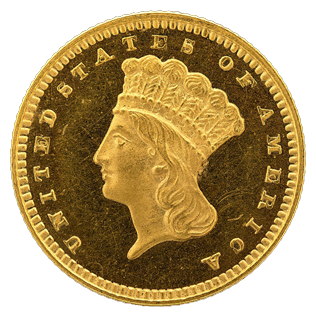The US Mint ceased production of gold coins in 1933 by order of President Franklin D. Roosevelt, ending a tradition dating back to the first US coins in 1792. By that time only $10 and $20 gold coins remained in limited production, $5 and $2.50 denominations having been discontinued in 1929. But in the 19th century gold coins were made in other denominations including a one-dollar gold piece that was widely circulated in the latter half of the century.
The Mettle is in the Metal
From the beginning, US coins, along with most other world coins, were made of either copper, silver or gold since their value was easily determined by how much of each metal they contained. Copper was used for the lowest denominations, silver for whole and fractional dollars, and gold for higher value coins.
But when large quantities of gold began flowing into the Treasury from the California Gold Rush, the government authorized the production of a one-dollar gold coin to supplement the silver dollar that had been in circulation since 1794.
The Diminutive Dollar
Since the value of a coin was determined by the metal it contained, one-dollar gold coins were necessarily small. Compared to the 1.5-inch diameter silver dollar that weighed nearly a full ounce (26.73 grams), the gold one-dollar coin was tiny. It measured barely half an inch (12.7 mm) when it debuted in 1849 and weighed only 5/100ths of an ounce (1.67 grams), making it the smallest US coin ever issued.
While some complained that its small size made it easy to lose, the gold dollar coin was popular and widely used in everyday transactions. In 1854 the coin was enlarged to 15 mm in diameter (.563 in.) to make it more convenient to handle, resulting in a thinner coin to preserve the amount of gold it contained (.04837 troy oz.).
Designs of the Gold Dollar
The original gold dollar was designed by James Longacre and featured a bust of Lady Liberty wearing a coronet surrounded by 13 stars on its obverse (face) with a ring of small beads on its edge and an intricate reverse design (by assistant engraver Peter Filatreu Cross). The numeral 1 sat above “Dollar” with the date just below. This was flanked by two leafed branches and “United States of America” wrapped around the wreath inside a ring of beads. This design was used from 1849-and is known as Type 1. Minor modifications were made until the design was discontinued in 1854, including “Open” and “Closed” wreath varieties.
The wider, thinner coins issued in 1854 needed a less intricate design, so Longacre changed Liberty’s coronet to a simpler native Indian headdress and the country’s name was moved to the obverse where it replaced the thirteen stars. This design, produced from 1854 to 1856 is known as the Type 2, or Small Head, variety.
Even this design had production problems, so in 1856 Longacre simplified and enlarged the bust, resulting in Type 3, Large Head which remained in production until the coin was discontinued in 1889.
Rarity and Value of the Gold Dollar
Type 1 Gold Dollars were struck at the Philadelphia, New Orleans, San Francisco, Dahlonega (D), and Charlotte (C) mints. Over 12.5 million Type 1 gold dollars were produced with the vast majority (11.47 million) struck from California gold at Philadelphia. Dahlonega and Charlotte relied on local supplies of gold, so their Type 1 output was barely 100,000 coins over five years. San Francisco struck 14,632 gold dollars in 1854, its only year of Type 1 production.
Any Type 1 Gold Dollars are pricey in mint condition with Philadelphia coins from tens of thousands to an MS63 Charlotte specimen that brought $690,000 at auction in 2004. More abundant Philadelphia coins in Very Fine grades can be had for a few hundred dollars. Similar 1854-S coins run over $1,000.
Only abut 1.5 million Type 2 “Small Head” gold dollars were made and prices range from over $100,000 to a few hundred based on rarity and condition. An MS64 1855-D sold for $164,500 in 2015.
While type 3 coins are more abundant given their 23-year life, there are several rarities, especially during the Civil War era when Dahlonega, Charlotte, and New Orleans mints were closed and overall production dropped to a few thousand coins annually. By the 1870s, demand for gold dollars had fallen precipitously as paper money became widely used (only 400 were struck in 1875). Extremely rare coins bring six figures while common mintages can be had for a few hundred dollars, even in mint condition.
For more information about US $1 gold coins, see the PCGS Coin Facts website.



